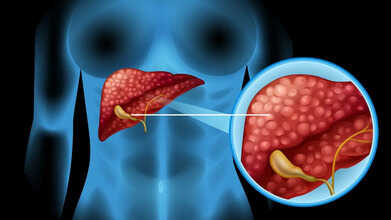- Health Conditions A-Z
- Health & Wellness
- Nutrition
- Fitness
- Health News
- Ayurveda
- Videos
- Medicine A-Z
- Parenting
How Bad Posture At Your Desk Can Trigger Anxiety And Insomnia

Image Credit: Canva
The new work life requires one to chase deadlines, desk jobs and prolonged screen time, which are now the norms, thus, poor posture risk is at its peak than ever. It is because, according to a health specialist, inappropriate sitting positions may bring the impact to humans, as the way people sit can cause not only various physical problems such as headache and neck pain but can also exacerbate mental illness like anxiety and insomnia. A closer look into the issue shows that even such simple matters as sitting posture could provoke serious health problems than one could realize.
Sitting at my desk every day, I never imagined that my posture could impact my well-being. But the headaches, restless nights, and creeping anxiety told a different story. Adjusting my sitting position felt awkward initially, but gradually, I noticed fewer aches and a calmer mind. Small changes truly make a big difference.
Link Between Posture and Mental Well-being
According to the British Heart Foundation, a person spends an average of 66.5 hours per week sitting, which translates into three full days of inactivity. This has seen many spend most of that time seated at desks or in front of screens, and negative effects are becoming apparent from poor posture. In reality, research shows that the majority of people, including twenty-year-olds, suffer from bad posture, which becomes a ripple effect on the body and mind.
Bad postures are not just slouching or sitting crooked. The health issues it can set off are numerous. Medical professionals say that bad postures can cause long periods of tension in the neck and spine muscles. This tension may cause extremely stressful headaches because the constant stress put on the head, neck, and the thoracic spine can sometimes get unbearable. However, poor posture is not solely held responsible for this. Studies found that slouching aids negativity in thinking patterns that can actually impair mood and cause increased stress and sometimes even anxiety and depression.
Maybe the worst consequence of having an improper posture is lack of sleep, known as insomnia. A forward-tilted neck, which is commonly known as "tech neck," can cause muscle fatigue, chronic neck pain, and even difficulty unwinding at night. The tension that builds up in the muscles of the neck and back can make it hard to relax, thus making it harder to fall asleep. This, in turn, contributes to a cycle of poor sleep and heightened stress, which further worsens feelings of anxiety and mental fatigue.
Dangers of "Tech Neck"
Among the many sitting positions that can damage your health, one stands out as being the most harmful: the "tech neck." The head tilts forward when working on screens, which most workers at a desk are familiar with, and also happens for people who spend more hours on their phones. This is because the head appears to weigh much heavier in the neck when the posture is forward. For example, a 30-degree angle can make the head's effective weight go up to 40 pounds and put tremendous stress on the neck and spinal muscles.
This unnatural strain often leads to muscle fatigue and discomfort, which can spiral into chronic neck pain. Over time, this tension doesn't just affect physical comfort; it can trigger persistent headaches and hinder the body's ability to relax, making it more difficult to wind down after a long day of work.
Impact of Prolonged Sitting
The physical consequences of prolonged sitting extend beyond the neck. As humans, our biology was designed to stand and walk. In sitting for long periods of time, the cardiovascular system is disrupted and, therefore, less effective when it comes to the proper functioning of our heart. Sitting also disrupts our digestive system from its norm. The bowel operates better when we are standing up and walking around, a situation not paid much attention to as one sits most of the day.
A sedentary life also contributes to a range of serious health issues, including increased risk factors for cardiovascular disease, diabetes, and even certain kinds of cancer. Over three million deaths are caused globally by physical inactivity worldwide annually. The implications of sitting for too long extend far beyond back pain or stiff muscles; they are related to a whole range of chronic illnesses that can drastically affect the quality of life and even life expectancy.
It is very important to know that posture not only affects the body but can also determine the mental state. According to studies, sitting in a particular way affects cognitive functions and emotional health. For example, slouching in a chair has been said to increase negative thoughts that lead to increased anxiety. However, sitting upright has been proven to promote a more positive attitude that improves mood and self-confidence.
Poor posture can also lead to degradation in cognitive function. Posture can cause shallow breathing leading to low oxygen levels throughout the body and low concentration of oxygen reaching the brain that can impair memory, concentration and overall cognitive performance.
With the advanced use of screens and sedentary work environments, most are unknowingly compromising their mental sharpness by neglecting posture.
How to Sit Best Position
Fortunately, it is easy to improve a posture, which can yield profound effects on the physical health and mental condition. Medical experts recommend "S" posture because gravity is not directed to the spinal muscles. Now, let's see how you do it:
1. Toes and heels flat on the ground: Place your feet flat on the ground such that your knees are kept the same height as that of your hips. As the pressure on your lumbar is reduced, keeping everything in proper alignment as well.
2. Adjust Chair Height: If your chair is too high or too low, your knees may not be at the correct angle, leading to discomfort. Adjust the height of your chair so that your feet rest comfortably on the floor.
3. Back Against the Chair: Ensure that your back is supported by the chair's backrest. If necessary, use a cushion for added support.
4. Refrain from Forward Tilting: Keep your head in neutral, avoiding the forward tilt that leads to "tech neck." This reduces the strain on your neck and spine.
5. Take Frequent Breaks: Even with perfect posture, sitting for long periods can still be harmful. Stand up, stretch, or walk around every 30 minutes to improve circulation and reduce muscle stiffness.
The effect of poor posture goes way beyond mere physical discomfort. It can impact your mental health, your ability to sleep and concentrate, and more. With the increasing hours spent sitting at desks, in front of screens, and on the go, it is more important than ever to pay attention to our sitting habits. Small changes in how we sit can make all the difference in our overall well-being.
We can reduce the risks of headaches, anxiety, insomnia, and chronic pain just by improving our posture and being proactive about reducing sedentary behavior. A healthy posture doesn't only look good; it also feels good, both for your body and mind. So go ahead and adjust your sitting position and give your body and mind the support they deserve to thrive.
These Popular Medicines May Trigger Serious Side Effects, Pharmacist Warns

Credits: Canva
We often reach for pills to soothe a headache, ease congestion, or help us drift off to sleep. Yet one experienced pharmacist believes that several everyday medicines tucked inside our bathroom cabinets may be causing more problems than they solve. Deborah Grayson, who has spent 13 years in pharmacy practice, has shared a firm warning about seven widely used treatments she personally avoids. Her concerns range from overpowering drowsiness that leaves people feeling disconnected to medications that can create a dependence over time.
Medicines That May Trigger Serious Side Effects
Below are the seven products she is cautious about, along with the alternatives she suggests.
1. Codeine
Codeine, sometimes sold in low doses mixed with paracetamol, is a strong opioid pain reliever. Deborah believes the danger of becoming reliant on it overshadows the intended relief.
She explained to the Daily Mail that opioid medicines convert to morphine inside the body and act on pain pathways to reduce discomfort, often bringing a warm, pleasant sensation that some describe as a mild “buzz.”
Her preferred approach for mild to moderate pain is sticking to paracetamol or ibuprofen. If those options fall short, she advises speaking with a doctor instead of moving to opioids.
2. Statins
Statins are prescribed to millions to help manage cholesterol levels, though debate continues about how effective they truly are for certain groups. Deborah said they should be used only when necessary, as people without clear risk may gain little benefit.
She noted that women may see even fewer protective effects, which raises concerns about whether many are being offered these drugs without enough consideration. Muscle aches, tiredness and possible liver irritation are recognised risks. She recommends having a detailed discussion with a healthcare professional to review whether another option may be more suitable.
3. Anti-depressants
Prescriptions for antidepressants in the UK have risen sharply. While these medicines are essential for many, Deborah believes that their long-term side effects and withdrawal symptoms can outweigh the positives for others.
She pointed out that access to cognitive behavioural therapy remains limited in an already strained health system, even though therapy may offer more lasting support for some patients. She added that antidepressants can cause nausea, headaches and sleep problems, and with long-term use may raise the risk of weight gain, diabetes and stomach bleeding.
Some people also develop sexual side effects, while withdrawal may bring dizziness, nausea, sharp shock-like sensations in the head, intense anxiety, irritability and disturbed sleep.
4. Gabapentin and Pregabalin
These medicines are often prescribed for nerve pain or fibromyalgia, yet Deborah feels that their side effects are not always fully explained.
She said they can lead to heavy drowsiness, poor balance, difficulty with concentration and memory issues over time, along with weight gain. Many people find the initial effects so overwhelming that they stop before any improvement is noticed, which may take several weeks.
Both medicines are controlled because of the possibility of addiction, and some users may develop both physical and psychological dependence.
5. Steroid Creams
Steroid creams are frequently used to manage eczema, psoriasis and other skin flare-ups. They are helpful in short bursts, although Deborah worries that many people continue using them far longer than advised because routine follow-up is often lacking.
Extended use may thin the skin and trigger painful reactions or infections. This creates a pattern where the discomfort returns, leading patients to reach again for the same cream, keeping them stuck in a cycle.
6. PPIs
Proton pump inhibitors, such as omeprazole or lansoprazole, are among the most common treatments for heartburn and acid reflux.
Deborah views these as a quick solution that can cause long-term harm if people rely on them for too long. She explained that stomach acid is necessary for breaking down food and absorbing nutrients, and PPIs interfere with this process. This can leave the stomach struggling to digest properly and may contribute to nutrient shortages.
She encourages people to consider dietary adjustments and stress management instead of long-term dependence on PPIs.
7. Laxatives
Many people turn to laxatives for constipation, and with so many available without a prescription, it is easy to depend on them more than intended. While they work well for short-term relief, consistent use may cause the bowel to slow down.
Deborah warned that many people eventually struggle to go to the toilet without help from these products. Short-term effects can include cramps, diarrhea, nausea, bloating, and trapped wind.
For ongoing constipation, she suggests increasing fibre intake or using options that draw more water into the bowel, such as Fybogel (ispaghula husk) or Macrogol sachets.
One Blood Type Linked To Higher Rates Of Fatal Liver Illness, Study Finds

Credits: Canva
A recent study suggests that a person’s blood group could play a role in whether they are more likely to develop severe liver conditions. Although most of us link blood type only with transfusions or donor matching, scientists now believe it may also offer clues about long-term liver health.
Higher Liver Disease Risk Linked to This Blood Group
A new study published in the journal Frontiers reports that individuals with blood group A have an increased chance of autoimmune liver disorders. In these conditions, the body’s own immune system mistakenly harms liver tissue, which can lead to ongoing damage and, in some cases, life-threatening liver failure.
The researchers also found that people with blood group B may have a slightly lower likelihood of certain liver-related concerns compared with those who have type A.
Why Your Blood Group Could Influence Liver Health?
Scientists have long examined how inherited blood groups relate to different illnesses. Some earlier findings noted that individuals with non-O blood types (A, B, or AB) tend to show higher activity of certain clotting factors and other changes in the body.
These differences may affect blood flow in the liver. For example, past studies found slightly increased levels of a clotting protein called von Willebrand factor in people with advanced liver disease who had non-O blood types, although it does not appear to be a major driver of risk.
Liver Conditions Connected to Certain Blood Groups
The latest research focused on autoimmune liver diseases such as:
- Autoimmune hepatitis, in which the immune system attacks liver cells.
- Primary biliary cholangitis (PBC), where the bile ducts inside the liver slowly break down.
Among these, autoimmune hepatitis showed a stronger link with blood group A. Blood group B appeared to carry a somewhat lower chance of PBC when compared with type A.
What Past Research Shows About Liver Cancer
Several earlier studies explored the relationship between blood group and liver cancer (hepatocellular carcinoma or HCC). Older data and a large meta-analysis found that people with type O blood were under-represented among those with liver cancer, suggesting that type O may be tied to a lower risk overall.
Why Knowing Your Blood Type Helps
Understanding your blood group can offer insight into potential health risks, though it does not mean you will certainly develop liver disease if you are type A or B. It remains only one part of a larger picture.
This may be especially important if you have blood type A or B and a family history of liver conditions. Routine health checks, liver screenings, and discussions with your doctor can help you watch for any early signs.
For now, it is clear that blood type is more than a simple classification, as it may hold useful information about future liver health.
Autoimmune liver disorders are uncommon, yet they can become serious when they are not spotted in time. A better grasp of the genetic and immune-related factors behind them can guide stronger prevention and treatment efforts. The authors of the study note that more research involving larger and more varied groups of people is needed to confirm these findings and to explain how different ABO blood types may influence the development of autoimmune liver problems.
Metformin, A Common Diabetes Medicine, Shows Surprising Brain Effects

Credits: Canva
According to the International Diabetes Federation, roughly one in nine adults worldwide lives with diabetes, and around 90% of these cases are type 2 diabetes. There is currently no cure for type 2 diabetes. Still, the condition can be managed through healthy lifestyle habits, such as staying active, as well as medication. One widely used medication is metformin, considered a first-line therapy for type 2 diabetes, and it has been prescribed for decades since the Food and Drug Administration (FDA) approved it in 1994. Recent research, however, suggests it may also act directly on the brain, opening the door to new approaches to treatment.
Metformin Found to Unexpectedly Affect The Brain
Scientists at Baylor College of Medicine in the US have discovered a brain pathway that metformin appears to influence, alongside its known effects on other parts of the body. "It has been widely believed that metformin lowers blood sugar mainly by reducing glucose production in the liver. Other studies have also highlighted its action in the gut," says Makoto Fukuda, a pathophysiologist at Baylor.
As reported by Science Alert, the researchers explained, "We turned our attention to the brain, given its central role in regulating overall glucose metabolism. Our goal was to understand whether and how the brain contributes to metformin’s anti-diabetic effects."
How Is Metformin Affecting Your Brain?
Earlier research by some of the same scientists had pinpointed a protein in the brain called Rap1, which influences glucose metabolism, especially in a region called the ventromedial hypothalamus (VMH).
In their 2025 study, experiments on mice showed that metformin reaches the VMH, where it helps combat type 2 diabetes by essentially shutting down Rap1. When mice were genetically modified to lack Rap1, metformin no longer affected a diabetes-like condition—even though other medications still worked. This provides strong evidence that metformin acts in the brain through a mechanism distinct from other drugs.
The researchers also examined which specific neurons metformin interacts with. This could eventually pave the way for treatments that target these neurons directly. "We found that SF1 neurons are activated when metformin enters the brain, indicating they are directly involved in the drug’s effect," they said.
Metformin Side Effects
While generally safer than many other type 2 diabetes medications, metformin does have side effects. Gastrointestinal issues such as nausea, diarrhea, and stomach discomfort affect up to 75% of users. Other risks can arise when there are underlying conditions like kidney problems, which may compound health concerns.
Metformin is also recognized as a gerotherapeutic—a medication that may slow aging processes in the body. For instance, it has been shown to reduce DNA damage and support gene activity linked to longer life.
Previous studies indicate that metformin can also protect the brain from wear and tear and may even lower the risk of long COVID, according to Science Direct.
© 2024 Bennett, Coleman & Company Limited

